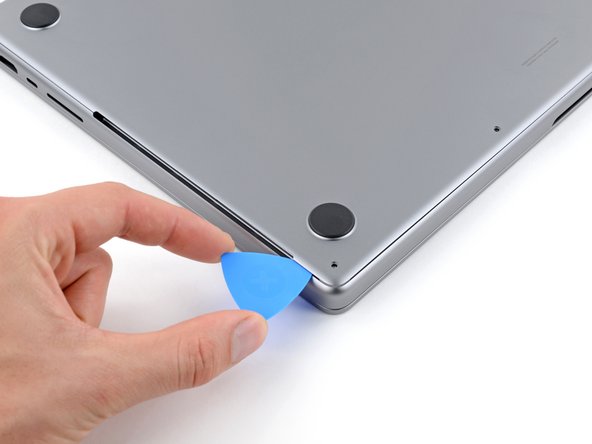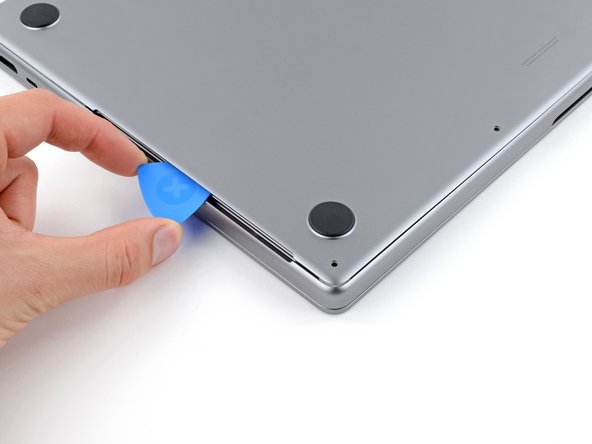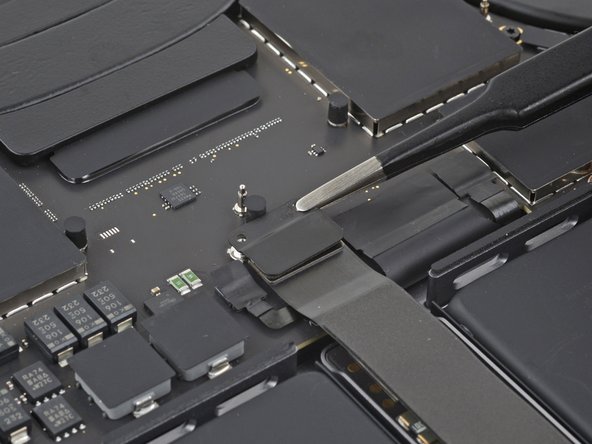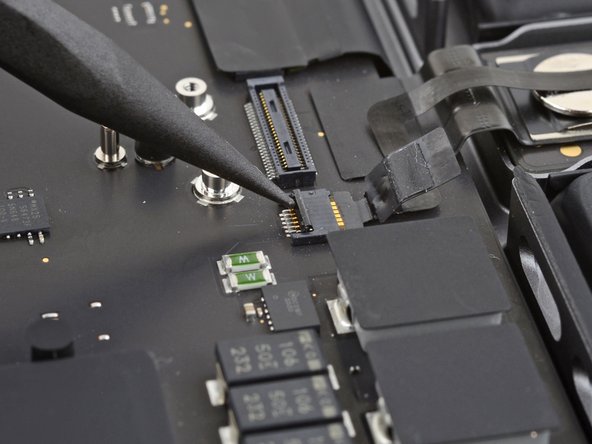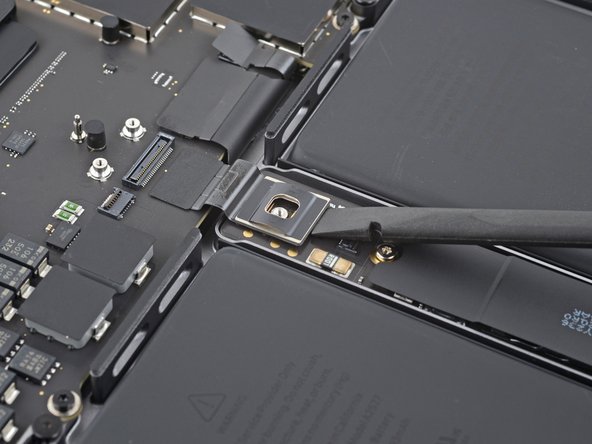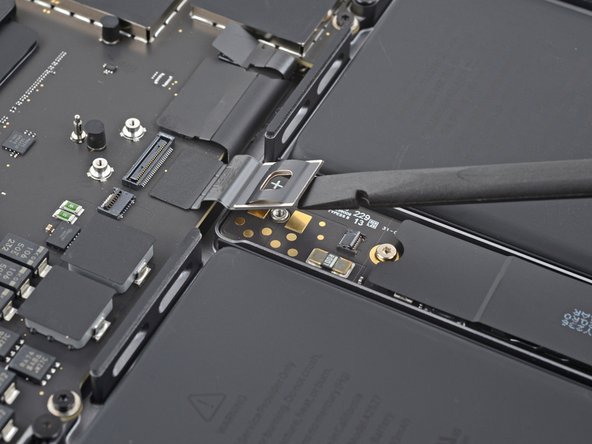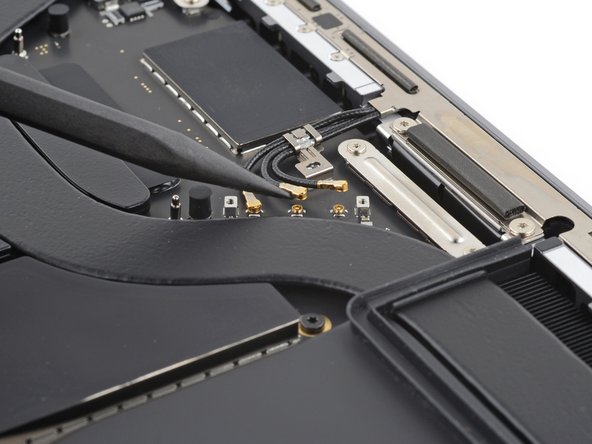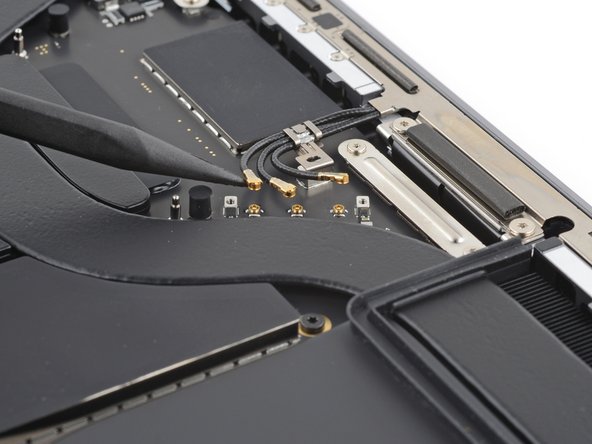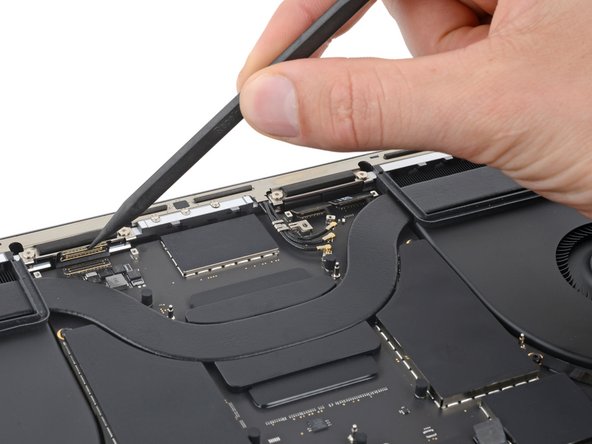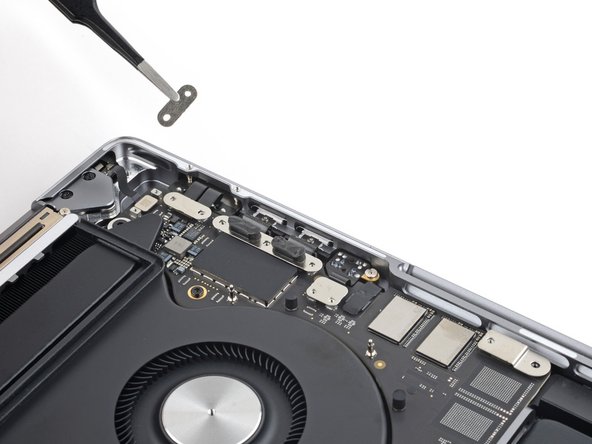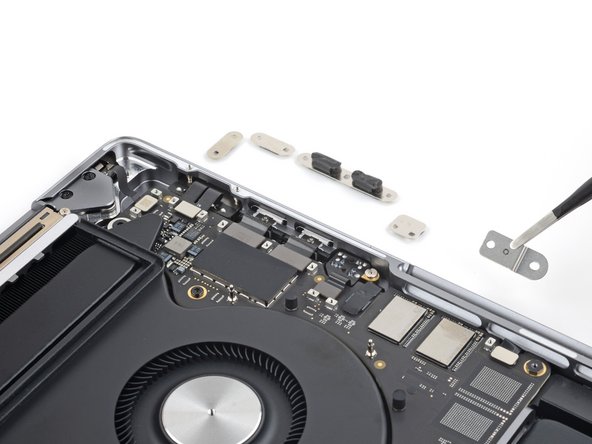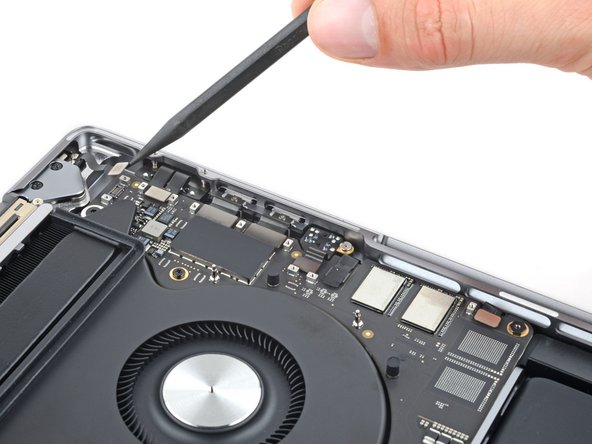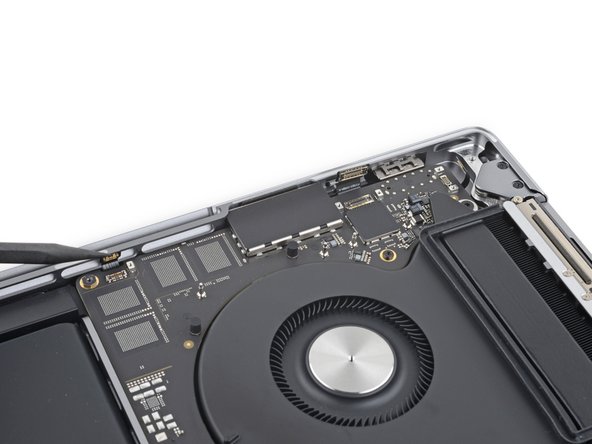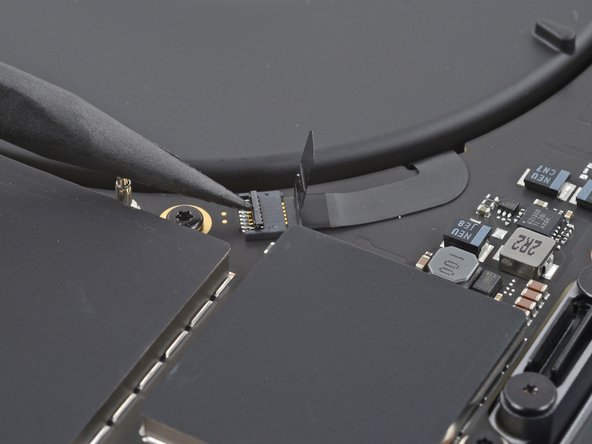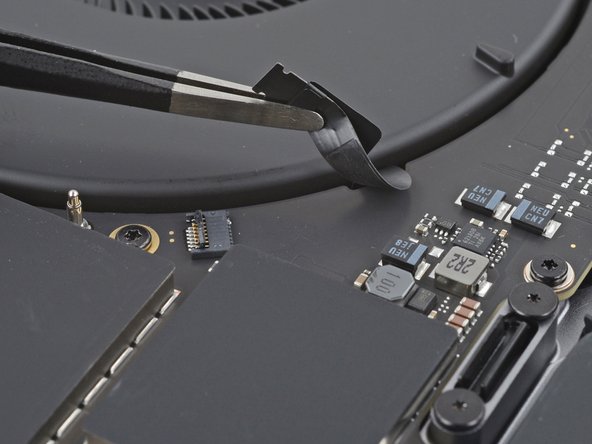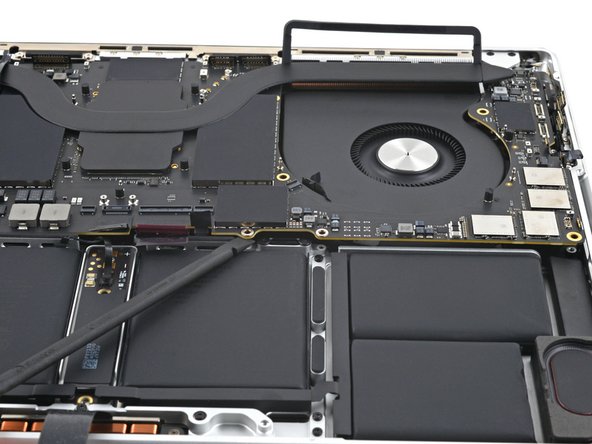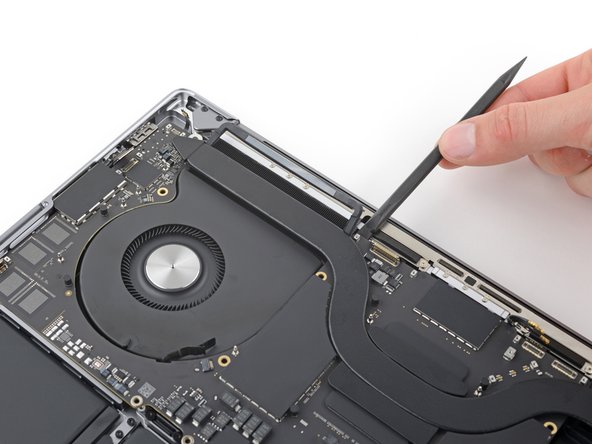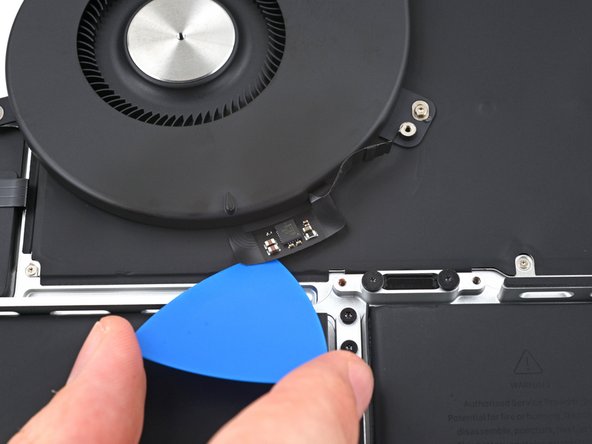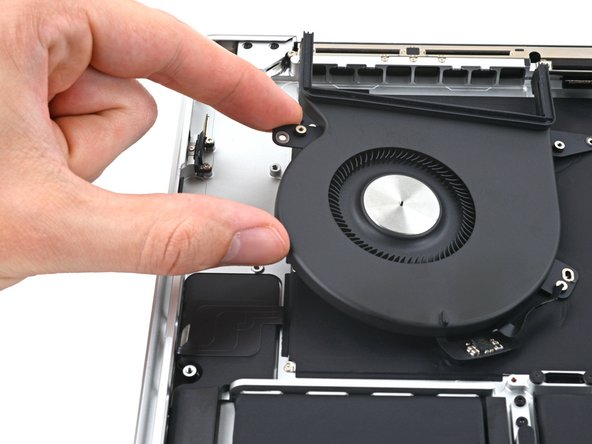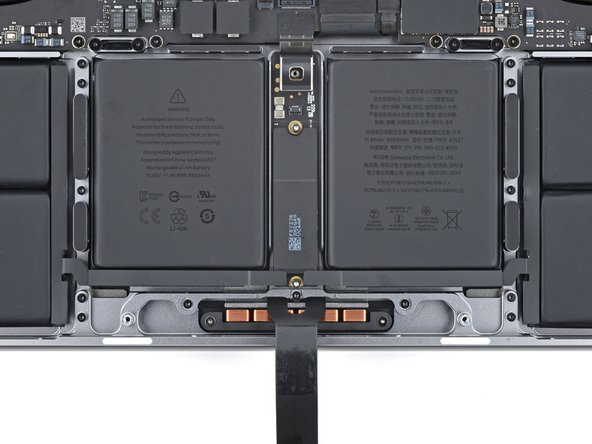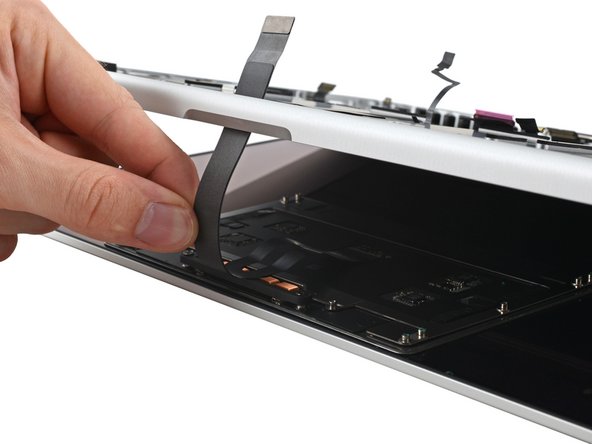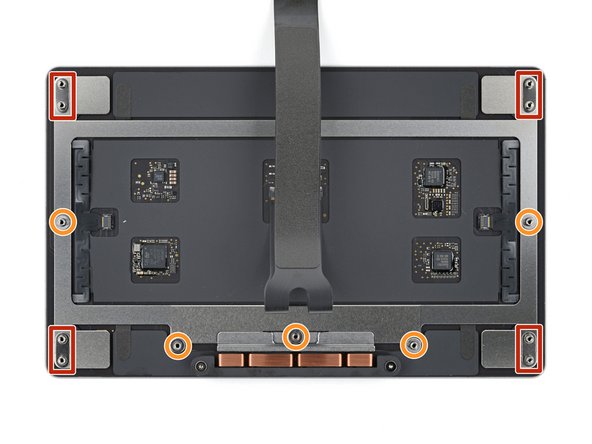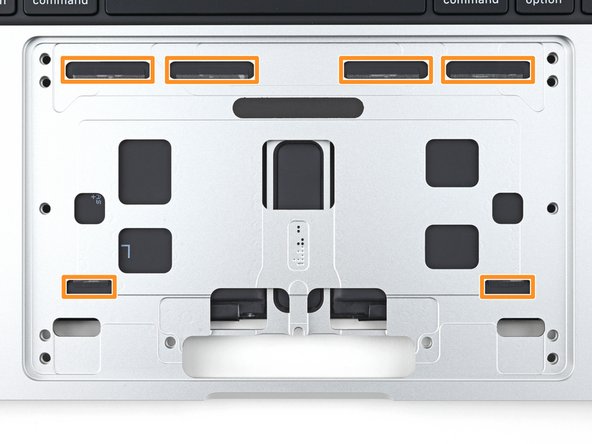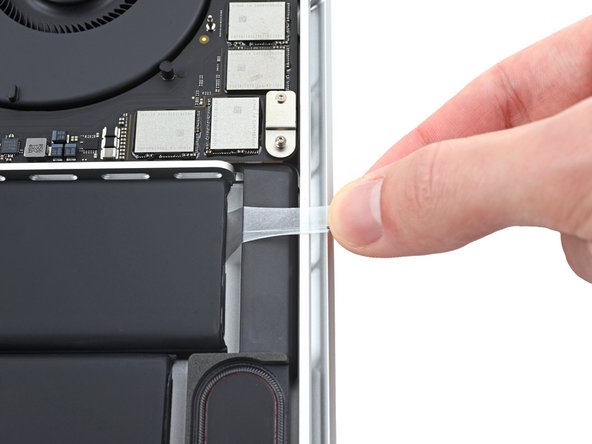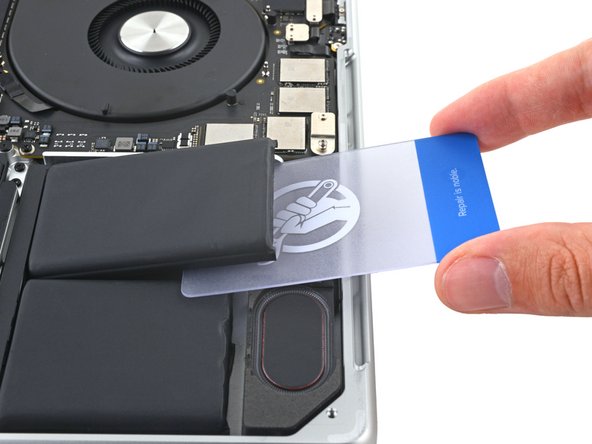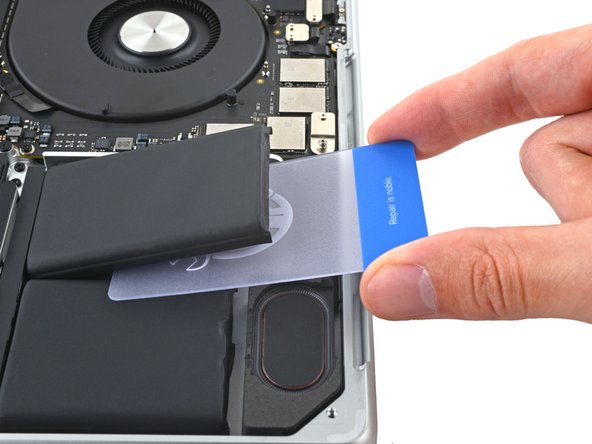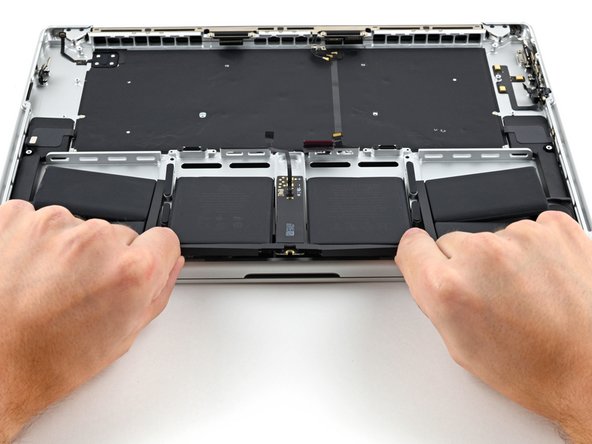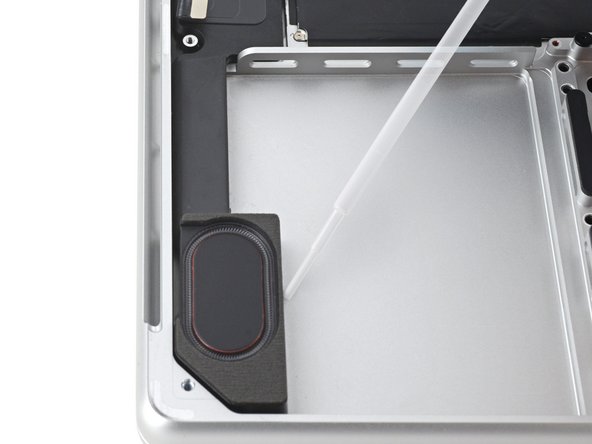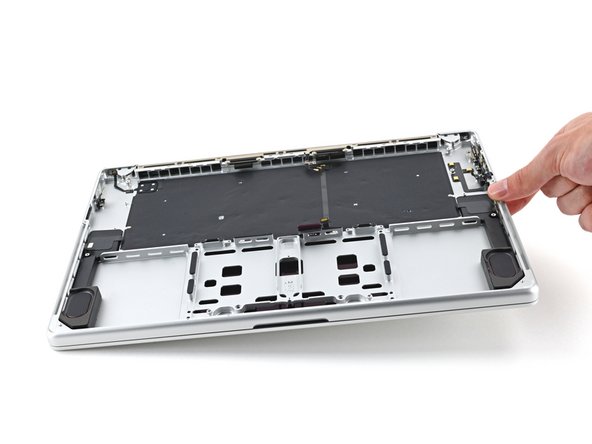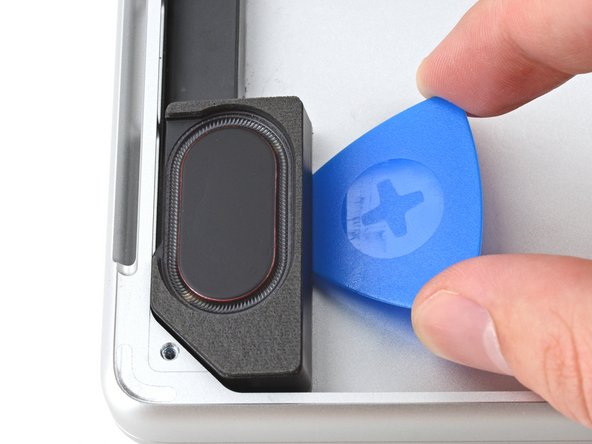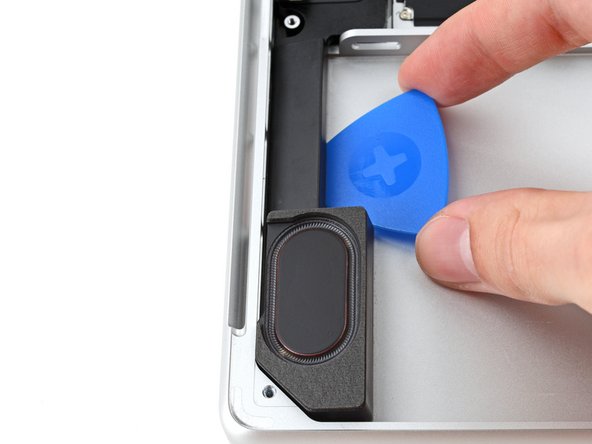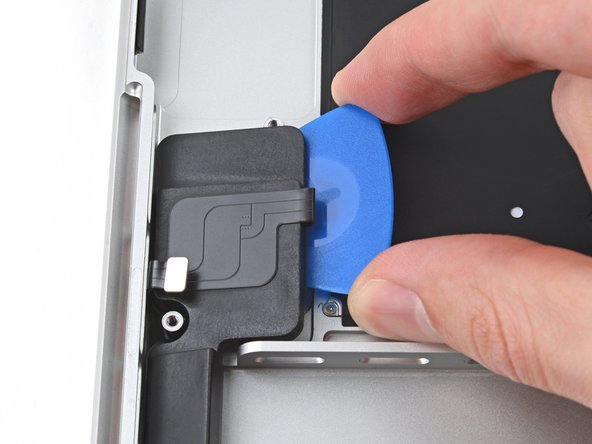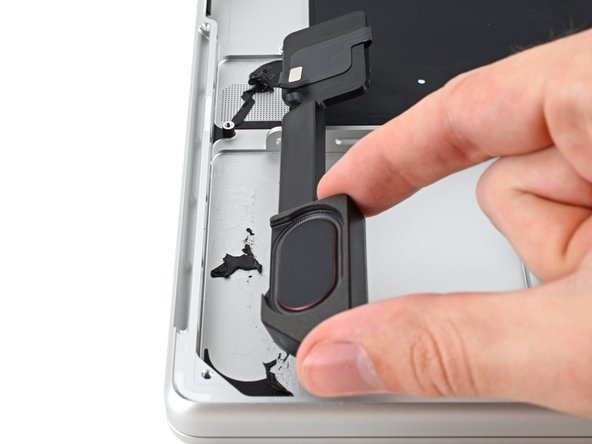MacBook Pro 16" 2023 Speakers Replacement
ID: 158742
Description: Use this guide to replace one or both of the...
Steps:
- Allow your MacBook's battery to drain below 10% before starting this repair. A charged battery may catch fire if damaged during the repair.
- Fully shut down your MacBook, close the lid, and flip it over. Keep the lid closed until you've physically disconnected the battery.
- Unplug the MagSafe cable and any accessories connected to your MacBook.
- Use a P5 pentalobe driver to remove the eight screws securing the lower case:
- Four 9.1 mm‑long screws
- Four 6 mm‑long screws
- Throughout this repair, keep track of each screw and make sure it goes back exactly where it came from.
- Apply a suction handle to the center of the lower case's front edge.
- Pull up on the suction handle to create a gap between the lower case and the frame.
- Insert an opening pick into the gap.
- Slide your opening pick around the bottom right corner and up the right edge of the lower case.
- If your pick gets stuck at the cutout, use your fingers to lift the lower case up slightly to allow your pick to slide underneath.
- Slide your pick until it reaches the middle of the cutout, or until the rightmost clip stops it from sliding.
- Twist your pick to release the two right clips.
- You'll hear and feel a pop when each of the two clips releases.
- Slide your opening pick around the bottom left corner and up the left edge of the lower case.
- If your pick gets stuck at the cutout, pry the lower case up slightly to allow your pick to slide underneath.
- Slide your pick until it reaches the middle of the cutout, or until the leftmost clip stops it from sliding.
- Twist your pick to release the left two clips.
- You'll hear and feel a pop when each of the two clips releases.
- Sliding clips along the back edge of the MacBook further secure the lower case. Separating these clips may require a lot of force—consider using gloves to protect your hands from the sharp edges of the lower case.
- Firmly pull the lower case away from the back edge, one corner at a time, to disengage the sliding clips.
- Keep the lower case flat to the MacBook. Don't pull upward until it's completely separated.
- Remove the lower case.
- To reinstall the lower case:
- Lay it down and align the sliding clips with the back edge of the MacBook. Press down on the lower case and slide it toward the back edge to engage the clips.
- When one side is engaged, it may push the other out of alignment. Check both sides as you push.
- Once the back corners of the lower case are secured and flush with the frame, press down along the middle of the lower case to engage the four remaining clips.
- You'll hear and feel each clip snap into place.
- Use a 3IP Torx Plus driver to remove the two 2.1 mm screws securing the trackpad cable bracket.
- Remove the bracket.
- Use the flat end of your spudger to pry up and disconnect the trackpad cable press connector from the logic board.
- To re-attach press connectors like this one, carefully align and press down on one side until it clicks into place, then repeat on the other side. Don't press down in the middle. If the connector is misaligned, the pins can bend and cause permanent damage.
- The trackpad cable is lightly adhered to the battery board.
- Peel the trackpad cable from the battery board.
- Move the cable over the front edge of the MacBook.
- Be careful not to crease the cable.
- Peel back the tape covering the battery data cable connector on the logic board.
- Use the point of a spudger or a clean fingernail to flip up the small locking flap on the battery data cable ZIF connector.
- Slide one arm of your blunt nose tweezers under the battery data cable.
- Grip the cable just below the head of the connector.
- Slide the connector straight out of its socket.
- Peel back the tape covering the battery data cable connector on the battery board.
- Use the point of your spudger or a clean fingernail to flip up the small locking flap on the battery data cable ZIF connector.
- Use blunt nose tweezers to grab the battery data cable just under the head of the connector and slide it straight out of its socket.
- The battery data cable is adhered to the battery board and logic board.
- Peel the cable from the battery board and the logic board.
- Remove the cable.
- Use a T5 Torx driver to remove the 3.9 mm pancake screw securing the battery connector.
- Use the flat end of your spudger to lift the battery connector away from the battery board, disconnecting the battery.
- Lift the connector high enough that it doesn't accidentally make contact during the repair, but no more than 45 degrees to prevent damaging its hinge.
- For added safety, place a barrier, such as a piece of a playing card, between the connector and board.
- Use your 3IP Torx Plus driver to remove the three 2.1 mm screws securing the antenna cable cover and bracket.
- Remove the antenna cable cover.
- Use the point of your spudger to pry up and disconnect the three antenna cables from the logic board.
- Pry only on the metal heads of the connectors. Avoid prying on the cables themselves.
- To reconnect antenna cables like these, hold each one in place over its socket and press down with the flat end of your spudger. The connector will snap into place.
- Use your 3IP Torx Plus driver to remove the four 2.1 mm screws securing the display cable covers.
- Remove both display cable covers.
- Use your spudger to pry up and disconnect all three display press connectors from the top of the logic board.
- Use a P2 pentalobe driver to remove the nine 1.5 mm screws securing the antenna bar.
- Due to their small size, these screws strip very easily. Make sure your driver is in good condition. Keep it vertical and apply constant downward pressure as you loosen the screws.
- During reassembly, don't overtighten these screws—ensure that they're threading in properly, then tighten only until they're snug.
- Use your T5 Torx driver to remove the six remaining screws securing the antenna bar:
- Four 3 mm screws
- Two 7.5 mm screws
- Pull the antenna bar straight up and out of the frame to remove it.
- Use your 3IP Torx Plus driver to remove the 11 screws securing the five cable covers to the right side of the logic board:
- Nine 2.1 mm screws
- One 2 mm screw
- One 3.5 mm screw
- Remove all five cable covers from the right side of the logic board.
- Use the point of your spudger to pry up and disconnect the six press connectors from the right side of the logic board.
- Use blunt nose tweezers to peel back the tape covering the microphone connector.
- Use the point of your spudger or a clean fingernail to flip up the small locking flap on the microphone ZIF connector.
- Use blunt nose tweezers or your fingers to grip the cable tape and slide the connector straight out of its socket.
- Use your 3IP Torx Plus driver to remove the six screws securing the three left cable covers to the logic board:
- Four 2.1 mm screws
- One 2 mm screw
- One 3.5 mm screw
- Remove all three cable covers from the left side of the logic board.
- During reassembly, orient the middle cable cover for the headphone jack with its flat edge toward the bottom of the MacBook.
- Use the point of your spudger to pry up and disconnect all three press connectors from the left side of the logic board.
- Use blunt nose tweezers to peel back the tape covering the keyboard and keyboard backlight connectors near the battery connector.
- Use the point of your spudger or a clean fingernail to flip up the small locking flap on the keyboard backlight connector.
- This connector is the smaller of the two keyboard connectors.
- Use an opening tool or two fingernails to flip up the locking flap on the keyboard connector.
- This connector is the wider of the two keyboard connectors and may break if a narrow tool is used.
- Grab the tape on the heads of the keyboard and keyboard backlight cables and pull their connectors straight out of their sockets.
- Use blunt nose tweezers or your fingers to peel back the tape covering the right fan connector.
- Use the point of a spudger or a clean fingernail to flip up the small locking flap on the right fan ZIF connector.
- Use blunt nose tweezers or your fingers to grip the cable tape and slide the connector straight out of its socket.
- The fan cables are very delicate. Be careful not to crease or tear them with your tools.
- Peel up the right fan cable from the logic board.
- Use blunt nose tweezers or your fingers to peel back the tape covering the left fan connector.
- Use the point of a spudger or a clean fingernail to flip up the small locking flap on the left fan ZIF connector.
- Use blunt nose tweezers or your fingers to grip the cable tape and slide the connector straight out of its socket.
- Peel up the left fan cable from the logic board.
- Use your T5 Torx driver to remove the ten screws securing the logic board to the frame:
- Six 3.8 mm screws surrounding the fans
- Four 4.6 mm screws along the bottom edge
- Use a 4 mm hex driver to remove the two 6 mm-long standoff screws securing the bottom corners of the logic board to the frame.
- During reassembly, first thread these bolts in with your fingers, then tighten them with your driver.
- Use a T6 Torx driver to remove the two 6 mm screws securing the heatsink and logic board to the frame.
- Insert the flat end of your spudger between the right side of the logic board and the frame.
- Keep your spudger away from any cables or connectors on the logic board.
- Gently pry the right edge of the logic board from its recess in the frame.
- The logic board may catch on the press connectors. Hold the connectors out of the way as you lift the board, if necessary.
- Insert your spudger between the bottom edge of the logic board and the frame.
- Gently pry up the logic board until you can grip it with your fingers.
- Don't pry against the battery or any connectors. Use protrusions in the frame for leverage.
- Hold the logic board up with one hand for the next two steps, as it tends to fall back into its recess.
- The HDMI port, SDXC port, and the fins along the top of the heatsink hold the logic board tight to the frame.
- Insert your spudger between the middle of the top edge of the logic board and the frame.
- Gently pry up until the fins along the top of the heatsink begin to lift from their recess in the frame.
- The heatsink fins may catch on the left rubber gasket. Hold the gasket out of the way as you lift the heatsink, if necessary.
- Insert your spudger at the top left edge of the logic board and pry it up over the left fan.
- Lift the right edge of the logic board and pull it to the right to free the HDMI and SDXC ports from their recesses.
- Guide the logic board out from underneath the display cables and the antenna cable bundle along the top edge.
- Remove the logic board.
- During reassembly, insert the left edge of the logic board first to make sure the ports go into their recesses.
- During reassembly, note the following:
- Make sure all 17 cables are above the logic board as you place it in the frame.
- Use the point of your spudger to pull cables out from under the logic board if they slip underneath.
- Hold the rubber spacers out of the way so the fins can drop into their recesses.
- Align the heatsink by sliding the heatsink fins between the rubber spacers on each side of the MacBook.
- Use your spudger to peel off and remove the four screw covers.
- Each of the fan cables are lightly adhered to the frame.
- Insert the tip of an opening pick between each of the fan cables and the frame.
- Slide your pick along the edge of the cables to separate their adhesive.
- Use your 3IP Torx Plus driver to remove the four 3.3 mm screws securing the inner edges of the fans to the frame.
- Use your T5 Torx driver to remove the four 3 mm screws securing the outer edges of the fans to the frame.
- During reassembly, tighten these screws first.
- Remove the fans.
- Use your T5 Torx driver to remove the 13 screws securing the trackpad:
- Ten 5 mm screws
- Three 5.8 mm screws
- During reassembly, center the trackpad in the frame before fully tightening the screws.
- Open your MacBook slowly. The trackpad will remain on the screen.
- Be careful not to lose the nine washers from their screw posts on the trackpad. Without them, your trackpad won't fit properly.
- Guide the trackpad cable through its slot in the frame.
- Remove the trackpad
- Before installing your trackpad, make sure all nine washers are in place:
- Four rectangular washers
- Five circular washers
- Use your T5 Torx driver to remove the two screws securing the battery board to the frame:
- One 4.4 mm screw
- One 3.8 mm screw
- 14 stretch-release adhesive strips secure the battery cells to the frame:
- Eight strips along the left and right edges of the battery
- Six strips accessed from the trackpad recess
- Use blunt nose tweezers or your fingers to grip the black pull tab on each adhesive strip.
- Pull each strip out slowly and at a low angle to the frame. Give it plenty of time to stretch and un-stick.
- If any strips break off, try to retrieve them from under the battery with your fingers.
- If any of the 14 adhesive strips broke off and couldn't be retrieved, follow the next two steps to finish separating the adhesive. If not, you can skip the next two steps.
- Apply a few drops of highly-concentrated isopropyl alcohol (over 90%) under the battery near the broken adhesive strips.
- Wait one minute for the adhesive to soften.
- Insert a plastic card under each battery cell where the stretch-release adhesive strips broke.
- Slice the remaining adhesive and pry up to separate the cells from the frame.
- Slide the battery toward the bottom of the MacBook and remove it.
- During reassembly, apply new stretch-release adhesive to your battery and press each cell into place.
- Alternatively, you may use strong double-sided tape such as Tesa Tape to secure the battery.
- The remaining steps show you how to remove the left speaker. These steps also apply to the right speaker.
- Apply a few drops of highly-concentrated isopropyl alcohol (over 90%) along the edges of the left speaker.
- Lift the right edge of the MacBook to allow the isopropyl alcohol to flow underneath the left speaker.
- Wait one minute for the adhesive to soften.
- While you wait for the adhesive to soften, note where it's located under the speaker:
- Around the perimeter of the upper section
- Completely covering the middle section
- Along the edge facing the inside of the MacBook
- Insert an opening pick under the lower section of the speaker to separate the adhesive securing it to the frame.
- Slide your pick upward to separate the adhesive securing the middle section of the speaker.
- Leave this pick in place to prevent the adhesive from resealing.
- Insert a second opening pick between the upper section of the speaker and the frame.
- Use your upper opening pick to pry up the speaker and separate its adhesive.
- If the speaker feels stuck, apply a few more drops of isopropyl alcohol and slice around its perimeter.
- Remove the speaker.
- Remove the right speaker using the same process as the left one.
- If any adhesive remains, clean it with a few drops of isopropyl alcohol and wipe it with a lint-free or microfiber cloth.











